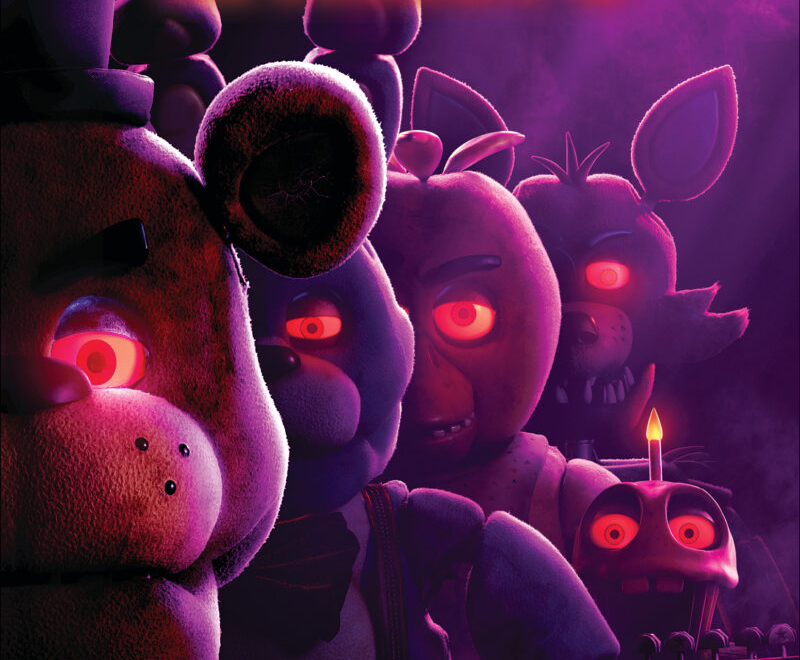“Five Nights at Freddy’s” arrives as a gory kids’ screenplay with a refreshing and surprising embrace of violence, defying some of the usual restraints of PG-13 horror films. The adaption of the popular video game franchise offers a thrilling, if uneven, cinematic experience that will surely become a gateway into horror for younger viewers.
The film “Five nights at Freddy’s” gets off to a thrilling start with a tense prologue, delving us into the midst of a guard’s escape from the mechanical monster within Freddy’s pizzeria, Foxy. The visceral and horrific sounds that follow leave a lot to the imagination, establishing the film’s intent right away with a cinematic journey for young horror audiences.
In the beginning of the story, we are introduced to Mike Schmidt, played by Josh Hutcherson, a security guard who lands the overnight shift at Freddy Fazbear’s Pizzeria, a decrepit, long abandoned 80’s building with a sinister reputation. Mike takes the job out of necessity, not knowing its disturbing past, hoping to provide for his sister Abby, played by Piper Rubio, and keep her from the clutches of his money hungry aunt Jane, played by Mary Stuart Masterson.
Watching the movie, it’s hard to be frightened or shocked when you can anticipate every scare. Near the beginning, you see Chika in the background of the kitchen, sneaking up on one of the men trashing Freddy’s pizzeria. I was expecting this to be a scene where I would’ve actually felt frightened or asked myself ‘where is Chika?’ That said, I knew almost every time she, and all the other animatronics would pop out and make an appearance.
I was never hugely into the original games, but I’ve had my fair share of jump scares from playing. I wish this movie encapsulated more of the game’s signature plot, rather than keeping us in the know when every animatronic popped out. The movie rarely felt horrific–at times, it barely felt suspenseful.
The lack of true horror, possibly due to the filmmakers wanting a PG-13 rating, is also contributed by the lack of any violence. For example, each time one of the animatronics would capture or kill one of the characters, there was either a cut to a black screen where you could hear said character in the background screaming, or a shadow on the floor or on the wall of the animatronics gruesomely killing different characters.
As the story begins to unfold, Mike’s personal demons, related to his younger brother’s unsolved disappearance, become evident. Josh Hutcherson (Mike Schmidt) delivers a compelling performance as a man clinging to a last spark of hope, replaying the day his brother vanished in his mind. His character’s desperation to make ends meet and provide a better life for his sister adds depth to the film.
The film tackles an interesting turn with the introduction of Freddy, Chica, Bonnie and Foxy, towering animatronic puppets and suits brought to life by Jim Henson’s Creature Shop. These eerie robots, covered in layers of dirt and grime, have a singular and chilling mode. Their lack of expressiveness makes them all the more frightening as they loom in back rooms and dimly lit hallways.
Director Emma Tammi, known for her work in “The Wind,” successfully creates a world within Freddy’s walls that is unsettling yet not hostile to the sensitive. The cinematography by Lyn Moncrief keeps the predominantly single-location setting interesting and foreboding, capturing the dynamic compositions that enhance the film’s atmosphere. The film’s vibrant score by the Newton Brothers and detailed production design by Marc Fisichella evoke nostalgia that feels almost tangible, immersing the audience in the eerie ambiance of the pizzeria.
But where “Five Nights at Freddy’s” stumbles is in its attempts to layer on additional complexities. The film introduces various characters, including Mike’s career counselor, Steve Raglan, played by Matthew Lilard, and a local cop, Vanessa, played by Elizabeth Lail, who provide exposition about the tragic past of Freddy’s and the design flaws of the animatronic exoskeletons. These character additions, along with a group of vandals intent on wrecking, steer the plot away from the simplicity of the original game.
Five nights at Freddy’s is a beloved video game that embraces the gory elements and disturbing themes while offering a thrilling cinematic experience. While it initially captures the eerie and tense atmosphere of the games, the film falters in its pursuit of a more complex narrative, losing sight of the horror elements that make the games so engaging. The scares and inspiration in the film gradually waned, leaving behind a film that feels more like a brand sustaining their name than an immersive cinematic adventure. It’s a film aimed primarily at pre-sold audiences, players of the original games and prioritizes franchise expansion over standalone entertainment.















